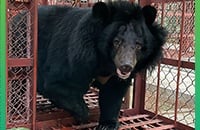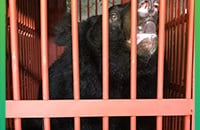Bears aren’t just smart – they’re funny too
24 October 2014
To says bears are sentient, intelligent animals is a given – but bear expert Else Poulsen goes one step further. She believes it's highly likely that bears love to joke.
Read her fascinating take on bear humour below where she explains:
- Bears perceive, reason and respond so can "get" the joke
- Bear cubs love to play, especially play wrestling
- Bears smile like humans and laugh "like Muppets"
- The strange "head in mouth" game that's hilarious to bears
In 2012, an impressive group of 1,996 neuroscientists signed The Cambridge Declaration on animal consciousness stating animals are self-aware, can experience emotions, problem solve, and manipulate their environment to their benefit.
And they do all of this on purpose!
While it may seem self-evident, this proclamation matters for a number of reasons. First, when almost 2,000 leading neuroscientists tell us that animals (and not just mammals) have the neuroanatomical, neurochemical, and neurophysiological substrates of conscious states along with the capacity to exhibit intentional behaviours, people tend not to argue because neuroscience is based more on measureable quantities than opinion. Second, this proclamation is an enormous help to animal caregivers like the staff of Animals Asia and myself who have spent countless hours attempting to explain that bears are truly sentient.
All bears have an arsenal of abilities allowing them to thrive in challenging, complex environments with many and varied cues to be sensed, understood and negotiated minute to minute. Looking at pictures of the white spirit bear fishing in the Great Bear Rainforest in British Columbia, Canada, the skills that come to mind are sight, sound, taste, touch, smell, thought, focus, balance, emotion, hunger, movement, success, and problem-solving. Captive bears are genetically endowed with the same considerable capabilities to perceive, reason, and respond. *
Bear care-givers have a unique opportunity not frequently afforded to field biologists, neuroscientists or psychologists. They care for the same bears day after day and get to know them as individual personalities. This is when the depth of the animal's behavioural complexity becomes apparent, like getting to know your companion dog.
It is commonly accepted that bear cubs play wrestle because it has been repeatedly reported in the vast majority of observable bear cubs. It is thought that play-wrestling may serve numerous purposes such as preparing the cub for defensive or offensive actions as an adult, helping to develop and maintain muscle mass, and increasing the environmental complexity needed for healthy brain development. Play behaviour in bear cubs is observable in the wild and one doesn't have to know the animals particularly well to understand the nature of the behaviour. While we can't ask the cubs directly if they are enjoying the activity, we assume they are since we recall ourselves as children having fun in such a way. However, one day I found myself in a position of considering whether or not bears share jokes.*
At the Calgary Zoo, Canada, I worked closely with a pair of male and female grizzly bears named Skoki and Khutzy. Skoki was a huge, ten year old wild born male bear that had recently been rescued as a 'problem' bear from Banff National Park. Although he had taken part in numerous food heists, his final caper involved walking through an open door at the Lake Louise bakery in broad daylight. Khutzy was a small, feisty ten-year-old female bear, half the size of Skoki, and born in captivity. Although Khutzy and Skoki had the same genetic drives of a brown bear they came from different cultures. Khutzy had never experienced wild bear living and Skoki was busy learning and acclimating himself to captive living. After some initial differences of opinion they were getting along well and spent a great deal of time playing together as if they were cubs. In the throes of play there was lots of smiling, open mouth laughing, and floppy exaggerated gesturing. One day I was stunned to see that Khutzy's face had literally disappeared into Skoki's giant mouth. Skoki was sitting on his haunches with his mouth wide open. Khutzy was standing on her hind legs and trying to cram her entire head into his mouth! I sat down on the ground right where I was and silently watched. *
Bear play, while rambunctious is often silent. Bears smile like humans do, with each side of the mouth turned up, but they smile for bear reasons of self-satisfaction. They laugh like gorillas with their mouth wide open, while silently moving or bobbing their head about, resembling one of Jim Henson's Muppets. Khutzy's throat-diving behaviour was repeated over and over and during intermission each bear laughed and smiled. Having never observed this behaviour before in any bear I had worked with, I took photos and made notes. I wondered if Khutzy and Skoki had made up this play behaviour, in a sense, to keep the peace. Skoki was almost twice the size of Khutzy and if he were of a mind to he could seriously hurt her. The act might have illustrated trust between the two of them: Khutzy showing that she trusted Skoki by sticking her face into his mouth and Skoki illustrating that he was trustworthy by not chewing it off. Frustratingly, I had no way of explaining the behaviour.*
A few years later at the Detroit Zoo, I worked with a wild, eight month old female American black bear cub named Miggy. After being found in the wild with a snout full of porcupine quills by concerned humans, Miggy was taken to a local veterinarian. Although the quills were removed, instead of seeing if she could be reunited with her mother, who was still in the area, the cub was given to a small zoo that was not able to properly care for her. Later, Miggy was re-homed at the Detroit Zoo and I became her surrogate mother. Knowing that Miggy had a genetic expectation to be cared for, taught, and socialized by a mother I worked to simulate those activities. We prepared and ate food together, play wrestled and napped together. I tried to teach her how to nest build, madly raking and fluffing straw as I had observed other bears do. Those sessions invariably broke down into riotous play, ending with straw everywhere except in a neat pile to lie on. It was during one of those bouts when complete mayhem prevailed that Miggy tried to stuff her entire face into my mouth as I was laughing. Initially she was successful because I didn't know it was coming. She fell back into the straw open-mouthed laughing, and then repeated it over and over. I tried to anticipate when it was coming so I could avoid Miggy's throat-diving attempts. It's not that I didn't want her to have fun it's just that I knew where that nose had been otherwise and I wasn't too keen on having it in my mouth! She repeated this behaviour over and over again on many different occasions and each time seemed to have a seriously fun time.*
I have wondered about the possible origin of such a behaviour having now observed it in two species of bears, both sexes, and in different age groups. When a mother bear escorts her cubs around their habitat the cubs frequently smell their mother's breath presumably to learn what their mother is eating so they can emulate it. How that might become a play behaviour or a joke, I don't know. Humour is said to be a function of many elements including a shared understanding of something incongruous and the element of surprise, in addition to being socially cohesive. In short, humour is not for sissies. It is complex and requires considerable intellectual and sentient prowess. Widely accepted as innate to humans, humour in animals is now gaining interest and research momentum. So is throat-diving a bear joke? I don't know but apparently it is hilariously funny, if you are a bear.
****
Animals Asia founder on Jill Robinson on joking bears
"We're in-debted to Else for her research and for sharing it with us here. We absolutely believe bears are capable of humour. Daily we laugh at, and are inspired by, moon bear "jokes" and it's not just us laughing. We can clearly see the bears get it too.
"Beyond this we believe bears are capable of a whole range of emotions, as profound as ours.
"Any animal carer will tell you that their companions express almost limitless emotions, but perhaps we learn to discount what we see with our own eyes when we look at the animals concerned. Perhaps too, because of our own guilt based on how we exploit animals as a species, we have been eager to believe scientists who have excused our wrongdoing – however counter-intuitive their findings.
"When we rescue and rehabilitate moon bears we start to see their personalities shine through. Personalities previously masked by extreme pain and boredom. Learning to put yourself in the position of an animal is an important step in embracing animal welfare. It's not just about understanding and believing in animal sentience – it's applying that belief to all species. Just as our instincts have always told us."
BACK










 Freedom after two decades: Moon bears Nang and Mua rescued
Freedom after two decades: Moon bears Nang and Mua rescued
 With heavy hearts we say goodbye to our beloved Tulip
With heavy hearts we say goodbye to our beloved Tulip
 Three moon bears rescued from notorious bear bile farming hotspots in Vietnam
Three moon bears rescued from notorious bear bile farming hotspots in Vietnam
